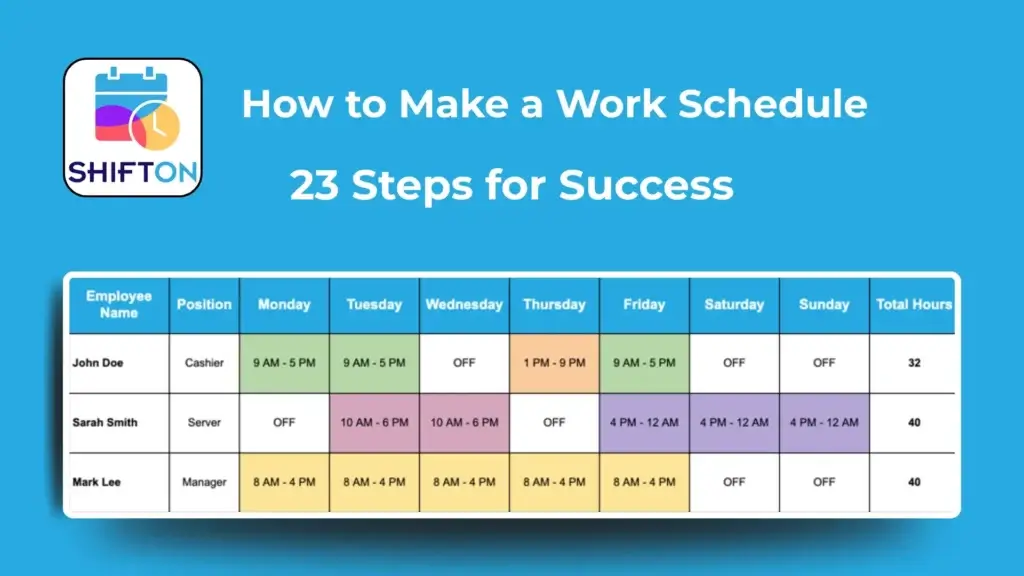What is a Work Schedule?
A work schedule is a structured plan that outlines when employees will work. It helps businesses:- Ensure sufficient coverage based on business demands.
- Distribute workload fairly among employees.
- Optimize productivity while minimizing labor costs.
- Maintain compliance with labor laws and company policies.
What Makes a Great Work Schedule?
Not all schedules are effective. A great work schedule is one that is clear, predictable, and accessible while allowing flexibility for both the employer and employees. The following key features make scheduling effective:Real-Time Updates
Business requires change, and schedules should be able to adapt to unexpected changes in real-time. If an employee calls in sick, managers should be able to adjust shifts instantly.Mobile Access
A modern work schedule should be accessible from any device, allowing employees to check their shifts, request changes, and get updates on the go.Alerts and Reminders
Automated shift reminders help employees stay on track, reducing absenteeism and ensuring that all shifts are covered without confusion.23 Tips on How to Make a Work Schedule
Step 1: Determine Your Labor Targets
Before you create a work schedule, you need to understand how many employees are required at different times. This involves analyzing business patterns, identifying peak and slow periods, and ensuring there are enough workers to meet demand without overstaffing.Start by assessing historical data to find out when customer traffic is highest. If you run a restaurant, for example, evenings and weekends may be the busiest times, while midweek mornings could require fewer staff members. For offices or retail stores, peak hours might be during lunch breaks or after work hours.Additionally, factor in employee productivity levels. Some employees work more efficiently at certain times of the day, so assigning shifts based on strengths can enhance operational efficiency. The goal is to balance labor costs while maintaining excellent customer service and business performance.Step 2: Adhere to Federal and Local Labor Laws
Every country, state, or region has different labor laws that govern work schedules. These laws cover aspects like maximum work hours, overtime pay, rest breaks, and required scheduling notices. Failing to comply with these laws can result in penalties, legal disputes, and a negative reputation among employees.Before finalizing any schedule, make sure it meets all relevant labor regulations. Some key compliance considerations include:- Ensuring employees do not exceed legal overtime limits without proper compensation.
- Scheduling required break periods, such as meal breaks and rest breaks.
- Complying with fair workweek laws, which require employers to give employees advance notice of their shifts.
Step 3: Get to Know Your Team
A well-balanced work schedule considers each employee's skills, strengths, and work preferences. This helps create a productive work environment where employees feel valued and perform at their best.Take the time to understand:- Who excels at which tasks and roles?
- Who prefers morning, evening, or night shifts?
- Who has limitations, such as childcare responsibilities or school commitments?
Step 4: Respect Your Employees' Scheduling Preferences
While business needs should come first, respecting employee scheduling preferences can improve morale and reduce absenteeism. Employees with predictable schedules are more satisfied and productive.To accommodate preferences without compromising operations, consider:- Allow employees to submit availability in advance.
- Creating a fair rotation for weekends and holidays.
- Providing shift trade options for employees who need flexibility.
Step 5: Involve Your Employees
Encouraging employees to participate in scheduling decisions fosters a collaborative work culture and improves overall satisfaction. When employees feel they have input, they are more likely to commit to their assigned shifts.Ways to involve employees include:- Using an open request system where employees can submit preferred workdays and times.
- Allowing employees to trade shifts with management approval.
- Conducting surveys or meetings to discuss scheduling policies and concerns.
Step 6: Gather Employee Availability
Before finalizing a work schedule, it’s essential to collect accurate information about employee availability. Doing so prevents last-minute changes, scheduling conflicts, and unfilled shifts.The best way to collect availability is through digital scheduling systems where employees can update their preferred working hours. This eliminates the need for constant back-and-forth communication and ensures schedules align with real-time employee availability.Step 7: Plan Ahead
One of the biggest scheduling mistakes is waiting until the last minute to assign shifts. Planning work schedules in advance helps prevent stress for both managers and employees.For optimal results:- Create schedules at least two weeks in advance.
- Identify potential conflicts and make adjustments early.
- Communicate schedules as soon as they are finalized.
Step 8: Create a Back-Up Plan
Even the best-planned schedules can face unexpected disruptions due to sick calls, emergencies, or last-minute changes. Having a backup plan ensures the business can continue running without major issues.Some backup strategies include:- Keeping a list of on-call employees who are available to cover shifts on short notice.
- Cross-training employees so they can handle multiple roles when needed.
- Implementing scheduling software that allows quick adjustments and shift swaps.
Step 9: Decide How You Want to Create Your Schedule
There are multiple ways to create a work schedule, each with its advantages and drawbacks. The most common methods include:- Manual scheduling – Using spreadsheets or whiteboards to create and adjust schedules manually.
- Automated scheduling software – Tools that generate work schedules based on business needs, employee availability, and compliance rules.
- Hybrid approach – Combining manual input with automation to improve accuracy and efficiency.
Step 10: Create Your Schedule
Once all key factors are considered, it's time to build the actual work schedule. Follow these steps for a structured approach:- Assign shifts based on business demand.
- Ensure a fair workload distribution.
- Account for legal requirements, including rest breaks and overtime.
- Adjust schedules based on employee availability.
- Review the schedule for conflicts or missing shifts.
Step 11: Publish Schedules in Advance
Employees appreciate having their schedules ahead of time so they can plan accordingly. Providing early access to schedules improves work-life balance, reduces no-shows, and enhances job satisfaction.Best practices include:- Posting schedules at least two weeks in advance.
- Sending schedule reminders before each shift.
- Allowing employees to confirm or request changes if necessary.
Step 12: Schedule Based on the Strengths of Your Employees
A well-balanced team work schedule is not just about filling shifts—it’s about assigning the right employees to the right roles at the right times. Employees have different skill sets, energy levels, and productivity patterns, and leveraging these strengths can improve efficiency.To schedule strategically:- Assign experienced employees to high-demand shifts to maintain service quality.
- Schedule new hires alongside senior employees for mentorship.
- Ensure that roles requiring technical expertise or leadership are covered by the best-suited staff.
Step 13: Review for Common Scheduling Errors
Even with careful planning, mistakes in scheduling happen. Before finalizing the work schedule, review it for:- Double booking – Two employees accidentally assigned to the same role at the same time.
- Understaffing during peak hours – Not having enough coverage during high-demand times.
- Back-to-back shifts – Employees scheduled for late-night shifts followed by early morning shifts, leading to fatigue.
- Excessive overtime – Employees working beyond legal or company limits.
Step 14: Share Your Schedule with Your Team
Once you create a work schedule, employees need quick access to their assigned shifts. Failing to distribute schedules properly can lead to confusion, missed shifts, and frustration.Best practices for sharing schedules:- Use cloud-based scheduling tools that allow employees to check shifts online.
- Post schedules in a centralized location, such as a bulletin board or company portal.
- Send automated notifications through SMS or email to remind employees about their upcoming shifts.
Step 15: Make Sure the Schedule is Easily Accessible
Employees should be able to view their shifts at any time, from anywhere. A mobile-friendly schedule system eliminates the need for paper schedules or constant calls to managers.To improve accessibility:- Use a scheduling platform with mobile compatibility.
- Provide employees with login access to their work schedules.
- Ensure that employees can request shift swaps or updates without confusion.
Step 16: Establish a Team-Wide Communication Method
An effective team work schedule goes hand in hand with a strong communication system. Employees should have a way to:- Ask questions about their shifts
- Request shift changes
- Report scheduling conflicts or concerns
- A group chat on a workplace app.
- A designated scheduling email for shift-related inquiries.
- An automated chatbot that can answer FAQs about scheduling.
Step 17: Prioritize Work-Life Balance
An effective employee schedule not only supports business operations but also respects employee well-being.To promote work-life balance:- Avoid scheduling employees for excessive overtime.
- Distribute weekend and night shifts fairly.
- Allow flexible scheduling options where possible.
Step 18: Offer Opportunities for Growth
Scheduling isn’t just about filling shifts — it’s also a chance to help employees develop their skills and careers.Ways to provide growth opportunities through scheduling:- Assign employees to new roles or responsibilities.
- Offer training shifts where employees can learn new skills.
- Rotate leadership opportunities among staff.
Step 19: Encourage Employee Feedback
Employees are directly affected by scheduling decisions, so it’s important to ask for feedback regularly.Methods to collect feedback include:- Anonymous surveys about scheduling fairness.
- Team meetings where employees can voice concerns.
- A suggestion box for schedule improvement ideas.
Step 20: Put Tech to Work
Manual scheduling can be time-consuming and prone to errors. Automated scheduling software simplifies the process and ensures that work schedules for employees are accurate and fair.Key features to look for in scheduling software:- AI-driven shift recommendations based on business needs.
- Automated shift swapping to allow employees to trade shifts easily.
- Labor law compliance tracking to prevent violations.
Step 21: Foster a Positive Work Environment
A work schedule isn’t just a list of shifts — it’s a reflection of company culture. A supportive scheduling approach creates a more motivated workforce.Ways to improve the work environment through scheduling:- Show flexibility when possible.
- Recognize employee needs and accommodate requests when feasible.
- Avoid last-minute schedule changes that cause stress.
Step 22: Look for Automation and Personalization Opportunities
Each employee has different preferences and availability. Using personalized scheduling options improves employee satisfaction and engagement.Some ways to personalize scheduling include:- Allowing preferred shift selection.
- Offering self-scheduling options for certain roles.
- Providing individualized shift reminders.
Step 23: Use the Best Tool for the Job
Creating a team work schedule manually can be overwhelming, especially for businesses with large workforces. Using advanced scheduling tools like Shifton helps managers create work schedule efficiently by:- Automating shift planning based on real-time business needs.
- Allowing employees to swap shifts seamlessly within the system.
- Providing real-time updates to avoid scheduling conflicts.
Types of Work Schedules
Different businesses require different scheduling structures to accommodate their unique operational needs. The type of work schedule used depends on industry demands, employee availability, and organizational priorities. Below are some of the most common work schedules that businesses implement.Full-Time
A full-time work schedule typically consists of 40 hours per week, though some industries may define it differently. Employees usually work a fixed number of hours per day, five days a week.Key Benefits of Full-Time Schedules:- Provides job stability and consistent income for employees.
- Ensures regular staffing levels for businesses that require consistent coverage.
- Often includes benefits such as health insurance, paid time off, and retirement plans.
Part-Time
A part-time work schedule generally involves working fewer than 40 hours per week. Employees may have fixed or variable shifts, depending on the employer’s needs.Key Benefits of Part-Time Schedules:- Offers flexibility for students, caregivers, or individuals balancing multiple jobs.
- Helps businesses reduce labor costs while maintaining adequate staffing.
- Provides a solution for businesses with seasonal or fluctuating demand.
Remote/Flexible Work Schedules
A remote or flexible work schedule allows employees to work from home or any location outside the traditional office environment. Hours may be fixed, variable, or output-based, depending on company policies.Key Benefits of Remote/Flexible Schedules:- Increases employee autonomy and work-life balance.
- Reduces commuting time and associated expenses.
- Expands the hiring pool, allowing businesses to recruit talent from different locations.
5-4/9 Work Schedule
The 5-4/9 work schedule is a compressed schedule where employees work nine-hour shifts for eight days in a two-week period, followed by one eight-hour shift and an extra day off.Key Benefits of the 5-4/9 Work Schedule:- Allows employees to have a three-day weekend every other week.
- Increases productivity by offering longer workdays but fewer total workdays.
- Reduces commuting costs and improves work-life balance.
2-2, 3-2, 2-3 Work Schedule
The 2-2, 3-2, 2-3 schedule is a rotating shift schedule where employees work in cycles of two days on, two days off, three days on, and so on.Key Benefits of the 2-2, 3-2, 2-3 Schedule:- Provides employees with regular days off for recovery.
- Ensures 24/7 business operations without excessive overtime.
- Balances workloads by rotating employees through different shifts.
4/10 Schedule
A 4/10 work schedule consists of four 10-hour workdays per week, followed by three days off.Key Benefits of the 4/10 Work Schedule:- Gives employees an extra day off each week, improving work-life balance.
- Reduces commuting expenses since employees travel to work fewer days.
- Helps businesses increase productivity by reducing the number of shift transitions.
Work Schedule Example and Template
Creating a structured and clear work schedule is crucial for efficient workforce management. A well-formatted schedule ensures employees know their shifts in advance, prevents scheduling conflicts, and improves overall team coordination.Below is an example of a basic work schedule template that can be used across different industries:| Employee Name | Position | Monday | Tuesday | Wednesday | Thursday | Friday | Saturday | Sunday | Total Hours |
| John Doe | Cashier | 9 AM - 5 PM | 9 AM - 5 PM | OFF | 1 PM - 9 PM | 9 AM - 5 PM | OFF | OFF | 32 |
| Sarah Smith | Server | OFF | 10 AM - 6 PM | 10 AM - 6 PM | OFF | 4 PM - 12 AM | 4 PM - 12 AM | 4 PM - 12 AM | 40 |
| Mark Lee | Manager | 8 AM - 4 PM | 8 AM - 4 PM | 8 AM - 4 PM | 8 AM - 4 PM | 8 AM - 4 PM | OFF | OFF | 40 |
How to Use This Work Schedule Template:
- List employee names and roles to clarify responsibilities.
- Assign shifts based on workload demand and employee availability.
- Ensure fair distribution of shifts to prevent overworking or understaffing.
- Indicate off days clearly, so employees know when they are not scheduled.
- Calculate total hours to track labor costs and ensure compliance with work regulations.
How Shifton Makes Creating Work Schedules Simple
Managing work schedules manually can be time-consuming, especially for businesses with multiple employees, rotating shifts, or 24/7 operations. Shifton, a smart workforce management tool, simplifies the process by offering:- Automated scheduling to eliminate manual errors.
- Employee self-service options for shift swaps and availability updates.
- Real-time updates to prevent conflicts and last-minute changes.
- Compliance tracking to ensure labor law adherence.

 English (US)
English (US)  English (GB)
English (GB)  English (CA)
English (CA)  English (AU)
English (AU)  English (NZ)
English (NZ)  English (ZA)
English (ZA)  Español (ES)
Español (ES)  Español (MX)
Español (MX)  Español (AR)
Español (AR)  Português (BR)
Português (BR)  Português (PT)
Português (PT)  Deutsch (DE)
Deutsch (DE)  Deutsch (AT)
Deutsch (AT)  Français (FR)
Français (FR)  Français (BE)
Français (BE)  Français (CA)
Français (CA)  Italiano
Italiano  日本語
日本語  中文
中文  हिन्दी
हिन्दी  עברית
עברית  العربية
العربية  한국어
한국어  Nederlands
Nederlands  Polski
Polski  Türkçe
Türkçe  Українська
Українська  Русский
Русский  Magyar
Magyar  Română
Română  Čeština
Čeština  Български
Български  Ελληνικά
Ελληνικά  Svenska
Svenska  Dansk
Dansk  Norsk
Norsk  Suomi
Suomi  Bahasa
Bahasa  Tiếng Việt
Tiếng Việt  Tagalog
Tagalog  ไทย
ไทย  Latviešu
Latviešu  Lietuvių
Lietuvių  Eesti
Eesti  Slovenčina
Slovenčina  Slovenščina
Slovenščina  Hrvatski
Hrvatski  Македонски
Македонски  Қазақ
Қазақ  Azərbaycan
Azərbaycan  বাংলা
বাংলা 

